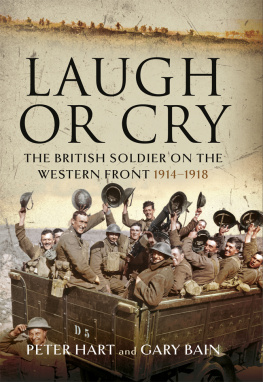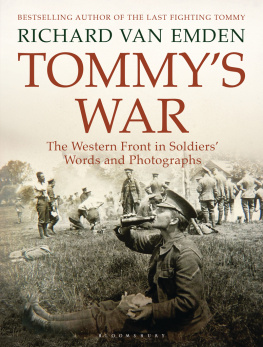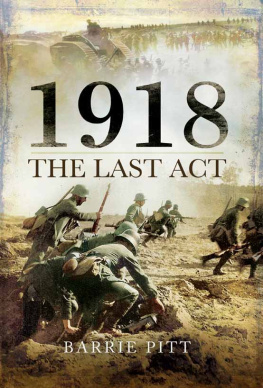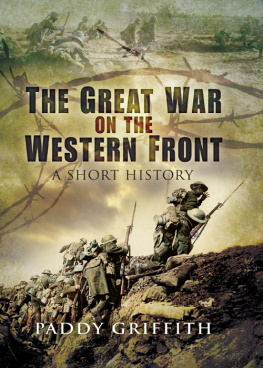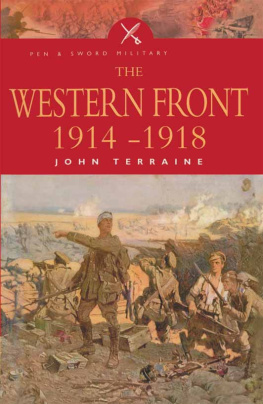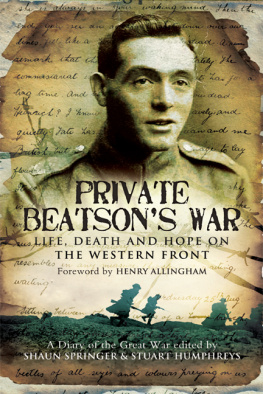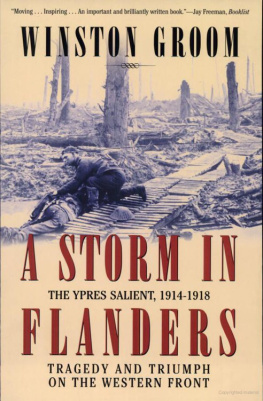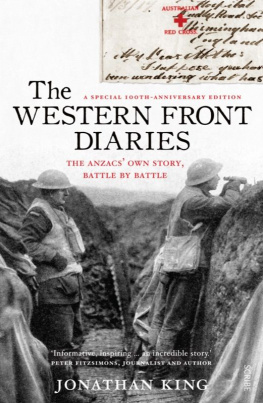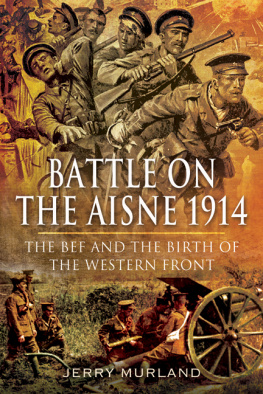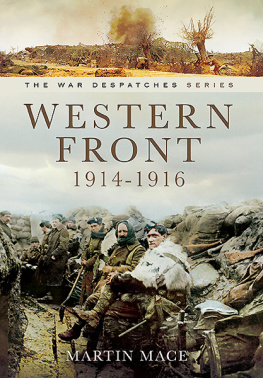BEFORE MY HELPLESS SIGHT

The History of Medicine in Context
Series Editors: Andrew Cunningham and Ole Peter Grell
Department of History and Philosophy of Science
University of Cambridge
Department of History
The Open University
Titles in this series include:
Negotiating the French Pox in Early Modern Germany
Claudia Stein
Contraception, Colonialism and Commerce
Birth Control in South India, 19201940
Sarah Hodges
Crafting Immunity
Working Histories of Clinical Immunology
Edited by Kenton Kroker, Jennifer Keelan and Pauline M.H. Mazumdar
Maritime Quarantine
The British Experience, c.16501900
John Booker
The Great Nation in Decline
Sex, Modernity and Health Crises in Revolutionary France c.17501850
Sean M. Quinlan
Before My Helpless Sight
Suffering, Dying and Military Medicine on the Western Front, 19141918
LEO VAN BERGEN
Vrije Universiteit (Medical Centre) Amsterdam, The Netherlands
Translated by
LIZ WATERS
ASHGATE
Leo van Bergen 2009
All rights reserved. No part of this publication may be reproduced, stored in a retrieval system or transmitted in any form or by any means, electronic, mechanical, photocopying, recording or otherwise without the prior permission of the publisher.
Leo van Bergen has asserted his moral right under the Copyright, Designs and Patents Act, 1988, to be identified as the author of this work.
Originally published in Dutch as Zacht en Eervol: Lijden en Sterven in een Grote Oorlog, Antwerp/The Hague 1999. The translation of a completely updated version of this book from Dutch into English was undertaken by Liz Waters.
Published by
Ashgate Publishing Limited
Wey Court East
Union Road
Farnham
Surrey, GU9 7PT
England
Ashgate Publishing Company
Suite 420
101 Cherry Street
Burlington
VT 05401-4405
USA
www.ashgate.com
British Library Cataloguing in Publication Data
Bergen, Leo van
Before my helpless sight : suffering, dying and military medicine on the Western Front, 19141918. (The history of medicine in context)
1. World War, 19141918 Medical care 2. World War, 19141918 Campaigns Western Front
I. Title
940.475
Library of Congress Cataloging-in-Publication Data
Bergen, Leo van
Before my helpless sight : suffering, dying and military medicine on the Western Front, 19141918 / by Leo van Bergen.
p. cm. (The history of medicine in context)
Includes bibliographical references and index.
ISBN 978-0-7546-5853-5 (alk. paper)
1. World War, 19141918Casualties. 2. World War, 19141918CampaignsWestern Front. 3. World War, 19141918Moral and ethical aspects. 4. World War, 19141918Medical care. 5. War casualtiesPsychological aspects. I. Title.
D609.A2B47 2009
940.475dc22
2008037954
ISBN 9781472454836 (Hbk)
ISBN 9781472454829 (ebk-PDF)
ISBN 9781472454836 (ebk-ePUB)
Contents
List of Illustrations
Whilst every care has been taken to ensure that each illustration has been reproduced to as high a standard as possible, the poor condition of many of the original items means that a number are less than perfect.
Acknowledgements
I want to thank all those who have contributed to the writing, translation and publication of this book. Aside from all my current and former colleagues at the Department of Medical Humanities (Metamedica) of the VU Medical Centre in Amsterdam, there are several people who should be mentioned by name. They are, in alphabetical order: Hans Andriessen, Hans Binneveld, Joanna Bourke, Chrisje Brants, Kees Brants, Dominiek Dendooven, Tom Gray, Chris Grayson, Petra Groen, Mark Harrison, Onno van der Hart, Maureen Healy, J.M. Hollander, Bert Keers, Jaap van der Linden, Anthea Lockley, Marieke van Loon, Anniek Meinders, Rob Ruggenberg, Emily Ruskell, Jan Schoeman, Herman Simissen, Hubert van Tuyll, Dick Visser, Leon Wecke, Menno Wielinga and Jay Winter. Of course Liz Waters deserves special mention for the beautiful translation. Marleen and Charlotte I thank just for being there. They are my stillness and certainty in this wonderful chaos called life.
The Publishers would like to acknowledge the support of the Nederlands Literair Productie-en Vertalingenfonds (NLPVF), the Stichting Studiefonds Medische Polemologie (Researchfund Foundation Medical Polemology), Leersum, The Netherlands and the Van Coeverden Stichting, Vrije Universiteit Amsterdam, for generous contributions towards the translation costs of this book.
Quotations taken from Under Fire by Henri Barbusse, translated by Robin Buss, copyright 2003 Robin Buss. Used by permission of Penguin Books Ltd (UK).
Quotations taken from Storm of Steel by Ernst Jnger, translated by Michael Hofman, copyright 2003 by Michael Hofmann. Used by permission of Penguin, a division of Penguin Group (USA) Inc., and Penguin Books Ltd (UK).
Introduction
The following work is not the result of weeks or months spent in dark bunkers and damp cellars, leafing through old documents page by mildewed page in the hope of coming upon a remark that will throw an entirely new light on the subject and supersede all previous knowledge in an instant. In that sense it is not an original work. So what exactly is it? This book is an attempt to bring together in a single readable volume all the diffuse knowledge available in primary and secondary literature on the subject of war, and more specifically the military casualties that result from it and the medical treatment they may or may not receive. At the root of the book lies the question of what can happen to a soldier between the moment he steps onto a train or ship bound for the theatre of battle and the point at which he is evacuated wounded or, whether dead or alive, buried in the ground. I have attempted to provide an answer in five chapters Battle, Body, Mind, Aid and Death drawing on experiences from the Western Front of a vast conflict that the French, British and Belgians still today refer to as the Great War.
The photo book Krieg dem Kriege!
In 191718 Wilfred Owen, the most famous of all British war poets, collected photographs of the dead and maimed, intending to publish them when the war was over. By telling the truth about the war he was fighting, he aimed to warn against any possible repeat. Friedrich had chosen them precisely because they were repulsive, and in any case the entire 191418 war had been repulsive.
Many people, including the historian Jay Winter, have argued that since the photographs in Friedrichs book were almost unbearable to look at they In the inter-war years in the Netherlands, which had been neutral in 191418 yet whose peace movement was the largest in Europe relative to its population, the organization Jongeren Vredesactie, or youth action for peace, made regular use of the photographs in Krieg dem Kriege!, along with a 1929 book derived from it called Nie Wieder Krieg (No More War), to underline the revulsion its members felt. The editors of a British counterpart to Friedrichs book, Covenants with Death, published in the early 1930s, likewise reasoned that revulsion would translate into aversion. Against the background of a decomposed corpse, T.A. Innes and Ivor Castle wrote on the front cover:
The purpose of this book is to reveal the horror, suffering and essential bestiality of modern war, and with that revelation, to warn the nation against the peril of foreign entanglements that must lead Britain to a new Armageddon.
Next page

